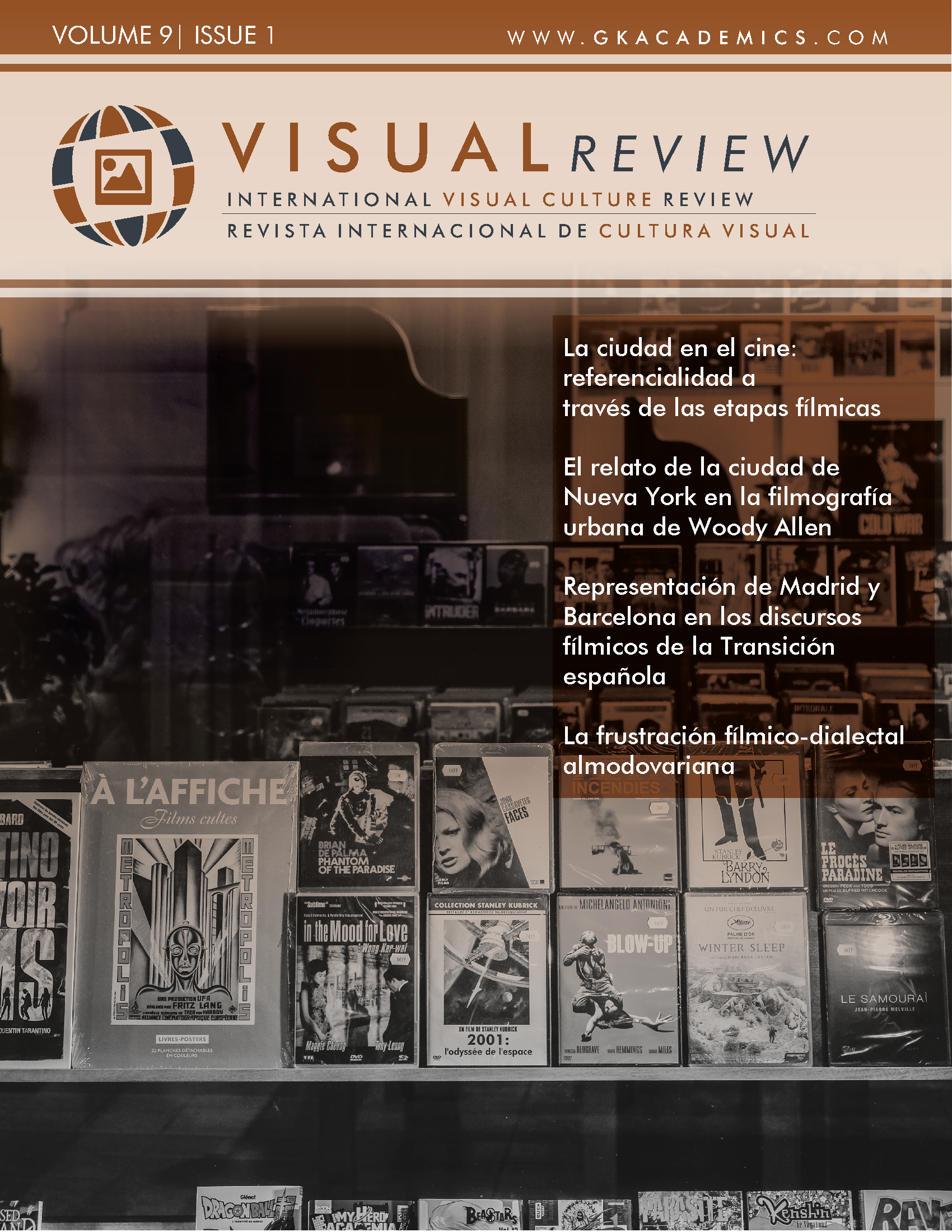Representation of Madrid and Barcelona in Films During the Spanish Transition
DOI:
https://doi.org/10.37467/gkarevvisual.v9.3192Keywords:
Spanish cinema, Spanish transition, Urban setting, Film analysisAbstract
As a reflection of the imminent change from late Francoism to the Spanish transition, discourses emerged in film narratives which portrayed aspects of society practically unaddressed until then, such as the LGTBIQ+ content, the “quinqui” marginality or the `S´ cinema. Madrid and Barcelona are presented as the main settings for new discursive constructs that portray a generation which differed from the preceding Francoist modes. This research analyses and exposes the synergy between characters and urban settings by which the city acts as an emotional map of the story and a location for change in the first films of Spanish democracy.
Downloads
Global Statistics ℹ️
|
526
Views
|
202
Downloads
|
|
728
Total
|
|
References
Antoniazzi, S. (2020). Barcelona y/en el cine: un recorrido histórico. Itinerarios: revista de estudios lingüisticos, literarios, históricos y antropológicos, 32, 131-156. DOI: https://doi.org/10.7311/ITINERARIOS.32.2020.08
Antonioni, M. (1976). El reportero [Película]. Cipi Cinematográfica.
Aguilar, C., Devesa, D., Losilla, C., Llinás, F., Marqués, J. L., Potes, A. y Torreiro, C. (1996). Conocer a Eloy de la Iglesia. Filmoteca Vasca.
Aguirre, J. (1978). Carne apaleada [Película]. Bautista Soler Crespo. Film 5.
Aranda, V. (1975). Clara es el precio [Película]. Impala.
Buñuel, L. (1950). Los olvidados [Película]. Ultramar Films.
Castelló, J. (2018). Cine quinqui. La pobreza como espectáculo de masas. Filmhistoria, 28(1-2), 113-128.
Chatman, S. (1990). Historia y discurso. Taurus.
Chávarri, J. (1977). A un dios desconocido [Película]. Elías Querejeta.
Comerón, L. J. (1974). Larga noche de julio [Película]. Movirama Telecine.
De Miguel, M. (2014). La red urbana de Woody Allen. Análisis del espacio narrativo cinematográfico [Tesis de Doctorado] Universidad Complutense de Madrid. https://eprints.ucm.es/id/eprint/27916/1/T35556.pdf
De la Iglesia, E. (1972). La semana del asesino [Película]. José Truchado. Atlas International Film.
De la Iglesia, E. (1978). El diputado [Película]. Ufesa.
De la Iglesia, E. (1980). Navajeros [Película]. Acuarius Films.
De la Loma, J. A. (1977). Perros callejeros [Película]. Profilms.
Escrivá, V. (1971). Aunque la hormona se vista de seda [Película]. Aspa producciones.
Fernández, R. (1970). No desearás al vecino del quinto [Película]. José María Reyzabal Larroy. Ízaro Films, Atlántida Films, Fida Cinematografica.
Lara Polop, F. (1977). Clímax [Película]. Calixto Pérez. Exclusivas Molpeceres.
Larraz, J. R. (1977). El fin de la inocencia [Película]. José María Cunilles Nogue. Filmax.
Martínez -Rigol, S. (2013). Ciudades de cine, el caso de Barcelona. Un buen ejemplo de industria creativa. Biblio3W Revista Bibliográfica de Geografía y Ciencias Sociales. https://raco.cat/index.php/Biblio3w/article/view/268926
Mérida-Jiménez, R. (2017). Transbarcelonas. Cultura, género y sexualidad en la España del siglo XX. Lectora: revista de dones i textualitat, 23, 182-184.
Merino, F. (1975). El comisario G [Película]. Kalender Films.
Neira Piñeiro, M. R. (1998). El espacio en el relato cinematográfico: Análisis de los espacios en un film. Archivum: Revista de la Facultad de Filosofía y Letras, 48, 373-397.
Olea, P. (1978). Un hombre llamado Flor de Otoño [Película]. José Frade Cinemat.
Rodríguez, L., Fraiz, J. A., & Alén, E. (2014). La trama y las imágenes en el cine como promoción turística de un destino. Evaluación del caso Vicky, Cristina, Barcelona. Papers de turisme, 51, 133-147.
Robles-Gutiérrez, R. (2016). El quinqui exploitation como fenómeno cinematográfico en España entre 1978-1985. Aspectos formales, temáticos y técnicos [Tesis de Doctorado]. Riuma, Universidad de Málaga https://riuma.uma.es/xmlui/bitstream/handle/10630/13330/TD_ROBLES_GUTIERREZ_Rafael.pdf?sequence=1&isAllowed=n
Romero Alba, R. (1971). Las melancólicas [Película]. Dauro Films.
Romero-Marchent, R. (1976). El límite del amor [Película]. Munder Films.
Sánchez, C. (4 de octubre 2019). El estigma de La Mina a través del cine quinqui. La Vanguardia. https://www.lavanguardia.com/local/barcelona/20191004/47650585961/la-mina-cine-quinqui-estigma-marginalidad-perros-callejeros-el-vaquilla-el-torete.html#foto-10
Torreiro, C. (1996). Del cineasta como cronista airado: historia e ideología. En C. Aguilar (Ed.), Conocer a Eloy de la Iglesia (pp. 15-48). Filmoteca Vasca.
Trueba, F. (4 de noviembre 1977). Las buenas intenciones. El País. https://elpais.com/diario/1977/11/04/cultura/247446003_850215.html
Vega Manrique, M. (2019). Geografía urbana y cine quinqui. Subjetivación en torno a la ciudad en Navajeros, de Eloy de la Iglesia. Revista Eviterna, 6, 54-64
Downloads
Published
How to Cite
Issue
Section
License
Those authors who publish in this journal accept the following terms:
-
Authors retain copyright.
-
Authors transfer to the journal the right of first publication. The journal also owns the publishing rights.
-
All published contents are governed by an Attribution-NoDerivatives 4.0 International License.
Access the informative version and legal text of the license. By virtue of this, third parties are allowed to use what is published as long as they mention the authorship of the work and the first publication in this journal. If you transform the material, you may not distribute the modified work. -
Authors may make other independent and additional contractual arrangements for non-exclusive distribution of the version of the article published in this journal (e.g., inclusion in an institutional repository or publication in a book) as long as they clearly indicate that the work was first published in this journal.
- Authors are allowed and recommended to publish their work on the Internet (for example on institutional and personal websites), following the publication of, and referencing the journal, as this could lead to constructive exchanges and a more extensive and quick circulation of published works (see The Effect of Open Access).













